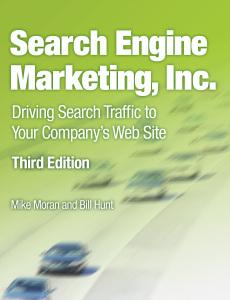For years, I struggled to explain to my mom what I do for a living. Now, I struggle to explain what I do for a living to my friends. The onus is on me because I am the expert in communications. I have been putting together my company’s capabilities deck and have really had to think about this very carefully. There are a lot of terms and many of them merge together and most of them are very complimentary. I guess it all boils down into the catch-alls of Internet Marketing, Digital Marketing, and Digital PR.
Social Media Marketing — according to Wikipedia, “social media marketing is the process of gaining website traffic or attention through social media sites.” This is a broad practice, encompassing social media strategy (what are your goals?), monitoring (what are people saying about you?), production (where are you going to live and what are you going to do?), development (is anyone listening?), engagement (have you been helped), and outreach (have you heard of us over here?). In its most basic, social media marketing is what you’re doing by creating an account on Twitter on behalf of your brand and maybe a Facebook Page; at it most complex, social media marketing is what major brands do every day, encompassing dozens of brands, active social media customer support, real-time conversation monitoring, and the kind of brand stalking that allows big brands to Like, Favorite, Retweet, Follow, and Comment on just about every single mention of their names and brands on Twitter, Facebook, Pinterest, Instagram, YouTube, and Vine (it’s pretty amazing when they’re that good). It’s a big tent, including very niche-but-powerful stunts like reddit’s Ask Me Anything, promotions, sales, raffles, contests, and even engaging #followfridays and #throwbackthursdays every single week without fail.
Influencer Marketing — according to Wikipedia, “Influencer marketing, (also Influence Marketing) is a form of marketing that has emerged from a variety of recent practices and studies, in which focus is placed on specific key individuals (or types of individual) rather than the target market as a whole. It identifies the individuals that have influence over potential buyers, and orients marketing activities around these influencers.” Previously limited only to bloggers, influence marketing has widened the angle of its lens to realize that there are all sorts of influentials all over the Internet. Some of the most influential people online live on YouTube, Twitter, Instagram, Vine, and—believe it or not—message boards, forums, email lists, and even community Listservs. Influencer marketing is good old fashioned traditional PR either expanded to include these new influencers or, like Gerris and me, specialists in digital PR. These days, Influencer Marketing includes Blogger Outreach and even specialties like Message Board Marketing.
Inbound Marketing — according to Wikipedia, “Inbound marketing is promoting a company through blogs, podcasts, video, eBooks, Newsletters, whitepapers, SEO, social media marketing, and other forms of content marketing which serve to attract customers.” While it might seem like this is anglerfish marketing (putting a pretty lure out there and just waiting for fish), it isn’t anymore. In 2014, inbound marketing is very proactive as Google becomes better and better and censuring and then preventing the sort of black hat and grey hat SEO tricks that have been the lifeblood of the what inbound marketing used to be (backlinks at any cost), it has now evolved into a combination of Search Engine Marketing, SEO, Social Media Marketing, and Content Marketing. In a post-Panda, Penguin, and Hummingbird world, true blue turnkey Inbound Marketing tactics are becoming less and less effective and the winners in Inbound Marketing have become their own little publishing empires.
Content Marketing — according to Wikipedia, “Content marketing is any marketing that involves the creation and sharing of media and publishing content in order to acquire and retain customers. This information can be presented in a variety of formats, including news, video, white papers, e-books, infographics, case studies, how-to guides, question and answer articles, photos, etc.” Notice a strange similarity to Inbound Marketing? They’re dance partners. I like to think of the relationship between Inbound Marketing and Content Marketing as being sort of like the relationship between the Chef’s Kitchen and the Manager’s Dining Room in a successful Restaurant: without waiters and marketing and management and the distribution that the business of the restaurant offers, a chef would just be a foodie home cook; however, without a chef, all is lost. And, without a talented chef, sous chef, and kitchen staff, the restaurant is probably doomed. Content Marketing is the newsroom, Inbound Marketing is the paper; Content Marketing is production, Inbound marketing is distribution.
 Search Engine Marketing — According to Wikipedia, “Search engine marketing (SEM) is a form of Internet marketing that involves the promotion of websites by increasing their visibility in search engine results pages (SERPs) through optimization and advertising.[1] SEM may use search engine optimization (SEO), which adjusts or rewrites website content to achieve a higher ranking in search engine results pages, or use pay per click (PPC) listings.” Because none of this actually works without Google’s love and referral, I have included SEM, a subset of which is Search Engine Optimization (SEO). Appealing to Robots and Algorithms might very well be more important these days than appealing to fickle and distracted Homo sapiens sapiens. Like Social Media Marketing, SEM can be as simple as optimizing your blog by site using SEO techniques, making sure you’re intentional with your writing, hosting on a fast server in a quality data center as close to the Internet Backbone as possible; or, it can be what Siemens needs to do at an Enterprise level, juggling dozens of brands across dozens of countries and languages across hundreds of products, egos, verticals, executives, through the constant swamp of politics to where an entire global conglomerate can be stitched together into a cohesive, understandable, thing—at least to Google, Bing, and Yahoo!. Sorry for the plug, but my colleague and the owner of this blog, Mike Moran, is coming out with the SEM guide—the actual SEM textbook— in a couple weeks, Search Engine Marketing, Inc.: Driving Search Traffic to Your Company’s Website. You should pre-order it now—you won’t be sorry. Learn more about the book here.
Search Engine Marketing — According to Wikipedia, “Search engine marketing (SEM) is a form of Internet marketing that involves the promotion of websites by increasing their visibility in search engine results pages (SERPs) through optimization and advertising.[1] SEM may use search engine optimization (SEO), which adjusts or rewrites website content to achieve a higher ranking in search engine results pages, or use pay per click (PPC) listings.” Because none of this actually works without Google’s love and referral, I have included SEM, a subset of which is Search Engine Optimization (SEO). Appealing to Robots and Algorithms might very well be more important these days than appealing to fickle and distracted Homo sapiens sapiens. Like Social Media Marketing, SEM can be as simple as optimizing your blog by site using SEO techniques, making sure you’re intentional with your writing, hosting on a fast server in a quality data center as close to the Internet Backbone as possible; or, it can be what Siemens needs to do at an Enterprise level, juggling dozens of brands across dozens of countries and languages across hundreds of products, egos, verticals, executives, through the constant swamp of politics to where an entire global conglomerate can be stitched together into a cohesive, understandable, thing—at least to Google, Bing, and Yahoo!. Sorry for the plug, but my colleague and the owner of this blog, Mike Moran, is coming out with the SEM guide—the actual SEM textbook— in a couple weeks, Search Engine Marketing, Inc.: Driving Search Traffic to Your Company’s Website. You should pre-order it now—you won’t be sorry. Learn more about the book here.
I had a dozen more in the list, including Wikipedia Management and Online Reputation Management (ORM), but I decided to keep it simple. To limit this post to just Online Brand Promotion. Please let me know if I missed anything.
I hope this breaks it down a little bit better. My agency does all of this stuff, so be sure to check out Gerris. Until then, Go git ’em Tiger!







